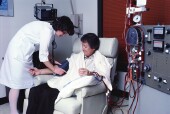
WEDNESDAY, Feb. 11, 2015 (HealthDay News) — More community hospitals are giving a powerful clot-busting medication to stroke victims, improving their chances of survival and recovery, new research shows.
These local hospitals are becoming more comfortable using the clot-busting drug tPA (tissue-plasminogen activator) due to a new treatment scheme known as “drip and ship,” said study author Dr. Kevin Sheth, chief of the neurocritical care and emergency neurology division at Yale School of Medicine in New Haven, Conn.
“Drip and ship” means that front-line hospitals quickly administer tPA to people suffering a stroke due to a blood clot in the brain, and then immediately transport them to a more advanced medical center with better stroke treatment facilities, Sheth explained.
Sheth’s study revealed that one in four stroke patients who received tPA did so under the “drip and ship” method, indicating that more local hospitals are now administering the clot-buster.
“The real goal is to get tPA to every eligible patient,” Sheth said. “Clearly, ‘drip and ship’ has become a common practice and one that is facilitating tPA use.”
The findings are to be presented Wednesday at the American Stroke Association annual meeting in Nashville, and they will be published simultaneously in the journal Stroke.
Treatment guidelines call for stroke patients to receive tPA as quickly as possible, if their stroke is caused by a blood clot (an “ischemic” stroke).
It’s the only FDA-approved clot-busting drug for stroke treatment, and is so valuable that the American Stroke Association refers to it as the “Gold Standard.” Ideally, patients should receive the drug within three hours of the beginning of a stroke, the researchers said.
“Time lost is brain lost in acute stroke,” said Dr. Jeffrey Saver, director of the UCLA Comprehensive Stroke Center and a spokesman for the American Heart Association/American Stroke Association. Saver noted that 2 million brain cells die every minute in which blood does not flow to the brain.
But local hospitals have been hesitant to administer tPA because the drug can cause serious side effects, such as bleeding in the brain, Saver and Sheth noted. Patients who receive tPA need constant monitoring from stroke experts equipped with advanced brain imaging equipment.
Experts came up with “drip and ship” as a way to increase the use of tPA in hospitals without such stroke facilities. By administering the drug and then sending the stroke victim on, local doctors improve the patient’s chances of survival and recovery.
“Basically it means you go to the closest hospital, the emergency department doc gives you tPA, and then after or even as it is administered you are transferred to another hospital by paramedics,” Sheth said.
Until now, though, there had been no nationwide analysis to see whether community hospitals have accepted “drip and ship” as a treatment plan for stroke victims, Sheth said.
Sheth and his team analyzed data on almost 45,000 ischemic stroke patients who received tPA within less than three hours at more than 1,400 hospitals between 2003 and 2010. Researchers compared “drip and ship” patients to those who received tPA at the hospital where they were admitted.
The investigators found that 23.5 percent of patients receiving tPA quickly were treated using “drip and ship.”
“It means this is a very common approach, and that’s good,” Saver said. “It means building out front-line hospitals to be ready to give tPA is working. It’s giving patients access to this proven medicine more quickly.”
Patients treated by “drip and ship” tended to be younger, more often male and more often white, the study authors noted.
Researchers also found that hospitals on the receiving end of “drip and ship” patients tended to have more beds, were more likely to be academic medical centers, more often had achieved certification as a designated stroke center, and maintained a higher volume of stroke cases per year.
“I think we’ll see even more ‘drip and ship’ in the coming years,” Saver concluded. “This study shows that it’s a safe way to go.”
More information
Visit the American Stroke Association for more on stroke treatments.
Copyright © 2025 HealthDay. All rights reserved.

